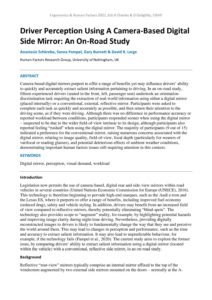| Document | Author Anastasia Schkreba, Sanna Pampel, Gary Burnett & David R. Large |
| Abstract Camera-based digital mirrors purport to offer a range of benefits yet may influence drivers’ ability to quickly and accurately extract salient information pertaining to driving. In an on-road study, fifteen experienced drivers (seated in the front, left, passenger seat) undertook an orientation-discrimination task requiring the extraction of real-world information using either a digital mirror (placed internally) or a conventional, external, reflective mirror. Participants were asked to complete each task as quickly and accurately as possible, and then return their attention to the driving scene, as if they were driving. Although there was no difference in performance accuracy or reported workload between conditions, participants responded sooner when using the digital mirror – suspected to be due to the wider field-of-view intrinsic to its design, although participants also reported feeling “rushed” when using the digital mirror. The majority of participants (9 out of 15) indicated a preference for the conventional mirror, raising numerous concerns associated with the digital mirror, relating to image quality, field-of-view, focal depth (particularly for wearers of varifocal or reading glasses), and potential deleterious effects of ambient weather conditions, demonstrating important human factors issues still requiring attention in this context. |

